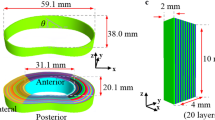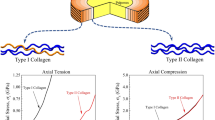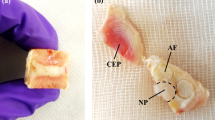Abstract
This study investigates differential multi-scale structure and function relationships of the outer and inner annulus fibrosus (AF) to osmotic swelling in different buffer solutions by quantifying tensile mechanics, glycoasaminoglycan (GAG) content, water content and tissue swelling, and collagen fibril ultrastructure. In the outer AF, the tensile modulus decreased by over 70% with 0.15 M PBS treatment but was unchanged with 2 M PBS treatment. Moreover, the modulus loss following 0.15 M PBS treatment was reversed when followed by 2 M PBS treatment, potentially from increased interfibrillar and interlamellar shearing associated with fibril swelling. In contrast, the inner AF tensile modulus was unchanged by 0.15 M PBS treatment and increased following 2 M treatment. Transmission electron microscopy revealed that the mean collagen fibril diameters of the untreated outer and inner AF were 87.8 ± 27.9 and 71.0 ± 26.9 nm, respectively. In the outer AF, collagen fibril swelling was observed with both 0.15 M and 2 M PBS treatments, but inherently low GAG content remained unchanged. In the inner AF, 2 M PBS treatment caused fibril swelling and GAG loss, suggesting that GAG plays a role in maintaining the structure of collagen fibrils leading to modulation of the native tissue mechanical properties. These results demonstrate important regional variations in structure and composition, and their influence on the heterogeneous mechanics of the AF. Moreover, because the composition and structure is altered as a consequence of progressive disk degeneration, quantification of these interactions is critical for study of the AF pathogenesis of degeneration and tissue engineering.








Similar content being viewed by others
References
Acaroglu, E. R., J. C. Iatridis, L. A. Setton, R. J. Foster, V. C. Mow, and M. Weidenbaum. Degeneration and aging affect the tensile behavior of human lumbar anulus fibrosus. Spine 20:2690–2701, 1995.
Aladin, D. M. K., K. M. C. Cheung, A. H. W. Ngan, D. Chan, V. Y. L. Leung, C. T. Lim, K. D. K. Luk, and W. W. Lu. Nanostructure of collagen fibrils in human nucleus pulposus and its correlation with macroscale tissue mechanics. J. Orthop. Res. 28:497–502, 2010.
Antoniou, J., T. Steffen, F. Nelson, N. Winterbottom, A. P. Hollander, R. A. Poole, M. Aebi, and M. Alini. The human lumbar intervertebral disc: evidence for changes in the biosynthesis and denaturation of the extracellular matrix with growth, maturation, ageing, and degeneration. J. Clin. Invest. 98:996–1003, 1996.
Asanbaeva, A., K. Masuda, E. J.-M. A. Thonar, S. M. Klisch, and R. L. Sah. Mechanisms of cartilage growth: modulation of balance between proteoglycan and collagen in vitro using chondroitinase ABC. Arthritis Rheum. 56:188–198, 2007.
Asanbaeva, A., K. Masuda, E. J.-M. A. Thonar, S. M. Klisch, and R. L. Sah. Cartilage growth and remodeling: modulation of balance between proteoglycan and collagen network in vitro with beta-aminopropionitrile. Osteoarthr. Cartil. 16:1–11, 2008.
Ateshian, G. A. The role of interstitial fluid pressurization in articular cartilage lubrication. J. Biomech. 42:1163–1176, 2009.
Atkinson, T. S., B. J. Ewers, and R. C. Haut. The tensile and stress relaxation responses of human patellar tendon varies with specimen cross-sectional area. J. Biomech. 32:907–914, 1999.
Bailey, A. J., R. G. Paul, and L. Knott. Mechanisms of maturation and ageing of collagen. Mech. Ageing Dev. 106:1–56, 1998.
Beckstein, J. C., S. Sen, T. P. Schaer, E. J. Vresilovic, and D. M. Elliott. Comparison of animal discs used in disc research to human lumbar disc: axial compression mechanics and glycosaminoglycan content. Spine 33:E166–E173, 2008.
Brüel, A., G. Ortoft, and H. Oxlund. Inhibition of cross-links in collagen is associated with reduced stiffness of the aorta in young rats. Atherosclerosis 140:135–145, 1998.
Buehler, M. J. Nanomechanics of collagen fibrils under varying cross-link densities: atomistic and continuum studies. J. Mech. Behav. Biomed. Mater. 1:59–67, 2008.
Buehler, M. J., and S. Y. Wong. Entropic elasticity controls nanomechanics of single tropocollagen molecules. Biophys. J. 93:37–43, 2007.
Cassidy, J. J., A. Hiltner, and E. Baer. Hierarchical structure of the intervertebral disc. Connect. Tissue Res. 23:75–88, 1989.
Chimich, D., N. Shrive, C. Frank, L. Marchuk, and R. Bray. Water content alters viscoelastic behaviour of the normal adolescent rabbit medial collateral ligament. J. Biomech. 25:831–837, 1992.
Elliott, D. M., and L. A. Setton. Anisotropic and inhomogeneous tensile behavior of the human anulus fibrosus: experimental measurement and material model predictions. J. Biomech. Eng. 123:256–263, 2001.
Eyre, D. R. Biochemistry of the intervertebral disc. Int. Rev. Connect. Tissue Res. 8:227–291, 1979.
Eyre, D. R., and H. Muir. Types I and II collagens in intervertebral disc. Interchanging radial distributions in annulus fibrosus. Biochem. J. 157:267–270, 1976.
Ezura, Y., S. Chakravarti, A. Oldberg, I. Chervoneva, and D. E. Birk. Differential expression of lumican and fibromodulin regulate collagen fibrillogenesis in developing mouse tendons. J. Cell Biol. 151:779–788, 2000.
Götz, W., S. Barnert, R. Bertagnoli, N. Miosge, H. Kresse, and R. Herken. Immunohistochemical localization of the small proteoglycans decorin and biglycan in human intervertebral discs. Cell Tissue Res. 289:185–190, 1997.
Grant, C. A., D. J. Brockwell, S. E. Radford, and N. H. Thomson. Tuning the elastic modulus of hydrated collagen fibrils. Biophys. J. 97:2985–2992, 2009.
Guerin, H. L., and D. M. Elliott. Quantifying the contributions of structure to annulus fibrosus mechanical function using a nonlinear, anisotropic, hyperelastic model. J. Orthop. Res. 25:508–516, 2007.
Haut, T. L., and R. C. Haut. The state of tissue hydration determines the strain-rate-sensitive stiffness of human patellar tendon. J. Biomech. 30:79–81, 1997.
Haut, R. C., and A. C. Powlison. The effects of test environment and cyclic stretching on the failure properties of human patellar tendons. J. Orthop. Res. 8:532–540, 1990.
Hoffman, A. H., D. R. Robichaud, II, J. J. Duquette, and P. Grigg. Determining the effect of hydration upon the properties of ligaments using pseudo Gaussian stress stimuli. J. Biomech. 38:1636–1642, 2005.
Iatridis, J. C., J. J. MacLean, M. O’Brien, and I. A. F. Stokes. Measurements of proteoglycan and water content distribution in human lumbar intervertebral discs. Spine 32:1493–1497, 2007.
Iatridis, J. C., J. J. MaClean, and D. A. Ryan. Mechanical damage to the intervertebral disc annulus fibrosus subjected to tensile loading. J. Biomech. 38:557–565, 2005.
Inkinen, R. I., M. J. Lammi, U. Agren, R. Tammi, K. Puustjärvi, and M. I. Tammi. Hyaluronan distribution in the human and canine intervertebral disc and cartilage endplate. Histochem. J. 31:579–587, 1999.
Jacobs, N. T., L. J. Smith, W. M. Han, J. Morelli, J. H. Yoder, and D. M. Elliott. Effect of orientation and targeted extracellular matrix degradation on the shear mechanical properties of the annulus fibrosus. J. Mech. Behav. Biomed. Mater. 4:1611–1619, 2011.
Lujan, T. J., C. J. Underwood, N. T. Jacobs, and J. A. Weiss. Contribution of glycosaminoglycans to viscoelastic tensile behavior of human ligament. J. Appl. Physiol. 106:423–431, 2009.
Maroudas, A., I. Ziv, N. Weisman, and M. Venn. Studies of hydration and swelling pressure in normal and osteoarthritic cartilage. Biorheology 22:159–169, 1985.
Mow, V. C., S. C. Kuei, W. M. Lai, and C. G. Armstrong. Biphasic creep and stress relaxation of articular cartilage in compression? Theory and experiments. J. Biomech. Eng. 102:73–84, 1980.
Natoli, R. M., D. J. Responte, B. Y. Lu, and K. A. Athanasiou. Effects of multiple chondroitinase ABC applications on tissue engineered articular cartilage. J. Orthop. Res. 27:949–956, 2009.
Natoli, R. M., C. M. Revell, and K. A. Athanasiou. Chondroitinase ABC treatment results in greater tensile properties of self-assembled tissue-engineered articular cartilage. Tissue Eng. Part A 15:3119–3128, 2009.
Nerurkar, N. L., W. Han, R. L. Mauck, and D. M. Elliott. Homologous structure-function relationships between native fibrocartilage and tissue engineered from MSC-seeded nanofibrous scaffolds. Biomaterials 32:461–468, 2011.
O’Connell, G. D., E. J. Vresilovic, and D. M. Elliott. Comparison of animals used in disc research to human lumbar disc geometry. Spine 32:328–333, 2007.
Panagiotacopulos, N. D., W. G. Knauss, and R. Bloch. On the mechanical properties of human intervertebral disc material. Biorheology 16:317–330, 1979.
Pearce, R. H., B. J. Grimmer, and M. E. Adams. Degeneration and the chemical composition of the human lumbar intervertebral disc. J. Orthop. Res. 5:198–205, 1987.
Peltz, C. D., S. M. Perry, C. L. Getz, and L. J. Soslowsky. Mechanical properties of the long-head of the biceps tendon are altered in the presence of rotator cuff tears in a rat model. J. Orthop. Res. 27:416–420, 2009.
Perie, D. S., J. J. Maclean, J. P. Owen, and J. C. Iatridis. Correlating material properties with tissue composition in enzymatically digested bovine annulus fibrosus and nucleus pulposus tissue. Ann. Biomed. Eng. 34:769–777, 2006.
Provenzano, P. P., and R. Vanderby, Jr. Collagen fibril morphology and organization: implications for force transmission in ligament and tendon. Matrix Biol. 25:71–84, 2006.
Roeder, B. A., K. Kokini, J. E. Sturgis, J. P. Robinson, and S. L. Voytik-Harbin. Tensile mechanical properties of three-dimensional type I collagen extracellular matrices with varied microstructure. J. Biomech. Eng. 124:214–222, 2002.
Roeder, B. A., K. Kokini, and S. L. Voytik-Harbin. Fibril microstructure affects strain transmission within collagen extracellular matrices. J. Biomech. Eng. 131:031004, 2009.
Roughley, P. J., M. Alini, and J. Antoniou. The role of proteoglycans in aging, degeneration and repair of the intervertebral disc. Biochem. Soc. Trans. 30:869–874, 2002.
Roughley, P. J., L. I. Melching, T. F. Heathfield, R. H. Pearce, and J. S. Mort. The structure and degradation of aggrecan in human intervertebral disc. Eur. Spine J. 15(Suppl 3):S326–S332, 2006.
Schmidt, M. B., V. C. Mow, L. E. Chun, and D. R. Eyre. Effects of proteoglycan extraction on the tensile behavior of articular cartilage. J. Orthop. Res. 8:353–363, 1990.
Screen, H. R. C., V. H. Chhaya, S. E. Greenwald, D. L. Bader, D. A. Lee, and J. C. Shelton. The influence of swelling and matrix degradation on the microstructural integrity of tendon. Acta Biomater. 2:505–513, 2006.
Screen, H. R. C., J. C. Shelton, V. H. Chhaya, M. V. Kayser, D. L. Bader, and D. A. Lee. The influence of noncollagenous matrix components on the micromechanical environment of tendon fascicles. Ann. Biomed. Eng. 33:1090–1099, 2005.
Shen, Z. L., M. R. Dodge, H. Kahn, R. Ballarini, and S. J. Eppell. Stress-strain experiments on individual collagen fibrils. Biophys. J. 95:3956–3963, 2008.
Singh, K., K. Masuda, E. J.-M. A. Thonar, H. S. An, and G. Cs-Szabo. Age-related changes in the extracellular matrix of nucleus pulposus and anulus fibrosus of human intervertebral disc. Spine 34:10–16, 2009.
Svensson, R. B., T. Hassenkam, C. A. Grant, and S. P. Magnusson. Tensile properties of human collagen fibrils and fascicles are insensitive to environmental salts. Biophys. J. 99:4020–4027, 2010.
Svensson, R. B., T. Hassenkam, P. Hansen, M. Kjaer, and S. P. Magnusson. Tensile force transmission in human patellar tendon fascicles is not mediated by glycosaminoglycans. Connect. Tissue Res. 52:415–421, 2011.
Thornton, G. M., N. G. Shrive, and C. B. Frank. Altering ligament water content affects ligament pre-stress and creep behaviour. J. Orthop. Res. 19:845–851, 2001.
Urban, J. P. G. The role of the physicochemical environment in determining disc cell behaviour. Biochem. Soc. Trans. 30:858–864, 2002.
Viidik, A., C. C. Danielson, and H. Oxlund. On fundamental and phenomenological models, structure and mechanical properties of collagen, elastin and glycosaminoglycan complexes. Biorheology 19:437–451, 1982.
Wiberg, C., A. R. Klatt, R. Wagener, M. Paulsson, J. F. Bateman, D. Heinegård, and M. Mörgelin. Complexes of matrilin-1 and biglycan or decorin connect collagen VI microfibrils to both collagen II and aggrecan. J. Biol. Chem. 278:37698–37704, 2003.
Zhang, G., Y. Ezura, I. Chervoneva, P. S. Robinson, D. P. Beason, E. T. Carine, L. J. Soslowsky, R. V. Iozzo, and D. E. Birk. Decorin regulates assembly of collagen fibrils and acquisition of biomechanical properties during tendon development. J. Cell. Biochem. 98:1436–1449, 2006.
Acknowledgments
This work was funded by the National Institutes of Health EB02425 and the Penn Center for Musculoskeletal Disorders.
Author information
Authors and Affiliations
Corresponding author
Additional information
Associate Editor Eric M. Darling oversaw the review of this article.
Rights and permissions
About this article
Cite this article
Han, W.M., Nerurkar, N.L., Smith, L.J. et al. Multi-scale Structural and Tensile Mechanical Response of Annulus Fibrosus to Osmotic Loading. Ann Biomed Eng 40, 1610–1621 (2012). https://doi.org/10.1007/s10439-012-0525-4
Received:
Accepted:
Published:
Issue Date:
DOI: https://doi.org/10.1007/s10439-012-0525-4




